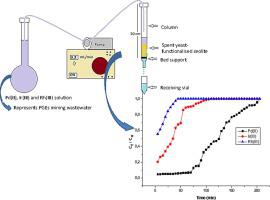Minerals Engineering ( IF 4.8 ) Pub Date : 2021-01-13 , DOI: 10.1016/j.mineng.2020.106770 Alseno K. Mosai

|
Economies of many countries around the world have been improved by the mining of precious elements such as gold and platinum group elements (PGEs). As such, the demand for these elements has increased over the years, which led to increased rate of mining. However, the resources and reserves of these elements have been reduced as a result. The alarming rate of mining indicates a need for secondary sources for precious elements. This study was aimed at using a cheap and efficient spent brewer’s yeast-functionalised zeolite to recover Pd(II), Ir(III) and Rh(III) from aqueous solutions. The solutions represent industrial wastewaters which normally contain PGEs which were lost during processing. The adsorbent bed height, solution pH, initial concentration and flow rate were optimised to obtain the best working conditions of the adsorbent. The bed depth service time, Adams-Bohart, Thomas, Yoon-Nelson, Clark column, Wolborska and modified dose response models were used to evaluate the dynamic behaviour of the column. The maximum recovery was achieved at longer bed height, low concentration (2 mg L−1) and low flow rate (2 mL min−1). The speciation of the elements at different conditions motivated the recovery outcome. For example, the dominant species Pd(II) and Ir(III) were negatively charged at highly acidic pH hence, their uptake was favoured by the positively charged surface but, the uptake of Rh(III) was not favoured at these conditions since, [RhCl(H2O)5]2+ and [RhCl2(H2O)4]+ were dominant and thus, repelled by the adsorbent. The success of the recovery of Pd(II), Ir(III) and Rh(III) from aqueous solutions makes the adsorbent a potential recovery agent in the PGEs mining industrial wastewater.
中文翻译:

使用流通塔模式,通过废啤酒酵母功能化沸石从水溶液中同时回收Pd(II),Ir(III)和Rh(III)
通过开采诸如金和铂族元素(PGE)等珍贵元素,世界许多国家的经济状况得到了改善。因此,这些年来对这些元素的需求增加了,这导致了采矿速度的提高。但是,结果是这些元素的资源和储备减少了。令人震惊的采矿速度表明,需要二级资源来获取贵重元素。这项研究的目的是使用廉价且有效的啤酒废酵母功能化沸石从水溶液中回收Pd(II),Ir(III)和Rh(III)。这些解决方案代表了通常含有在处理过程中损失的PGE的工业废水。优化吸附剂床的高度,溶液的pH值,初始浓度和流速,以获得最佳的吸附剂工作条件。床深度服务时间,Adams-Bohart,Thomas,Yoon-Nelson,Clark色谱柱,Wolborska和改进的剂量响应模型用于评估色谱柱的动态行为。在更长的床高度,低浓度(2 mg L-1)和低流速(2 mL min -1)。在不同条件下元素的形成促使恢复结果。例如,优势物质Pd(II)和Ir(III)在高酸性pH下带负电,因此,带正电荷的表面有利于它们的吸收,但是在这些条件下,Rh(III)的吸收不受欢迎,因为[RhCl(H 2 O)5 ] 2+和[RhCl 2(H 2 O)4 ] +是主要的,因此被吸附剂排斥。从水溶液中回收Pd(II),Ir(III)和Rh(III)的成功使吸附剂成为采矿工业废水的PGE中的潜在回收剂。


























 京公网安备 11010802027423号
京公网安备 11010802027423号